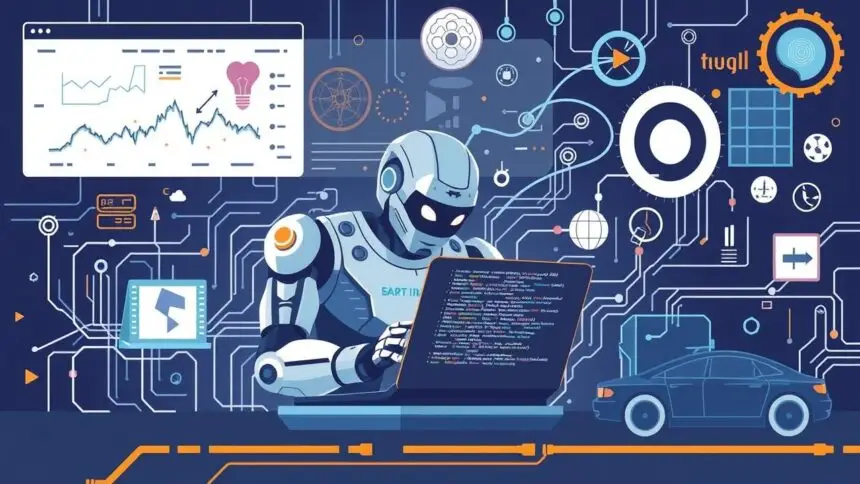Unlocking Intelligence: A Beginner’s Guide to Introduction to Machine Learning
Machine learning is revolutionizing the world as we know it. From recommending your favorite movies to detecting fraud in real-time, machine learning (ML) is the silent force behind many modern conveniences. But what exactly is machine learning, and how can you get started? Let’s dive into an introduction to machine learning and explore its fascinating world together.
1. What is Machine Learning?
Imagine teaching a child to recognize cats. You’d show them pictures of cats and tell them, “This is a cat.” Eventually, the child learns to recognize cats on their own. That’s essentially what machine learning does, but instead of a child, it’s a computer algorithm. Machine learning is a subset of artificial intelligence (AI) that enables computers to learn from data without being explicitly programmed.
1.1 The Basics of Machine Learning
At its core, machine learning involves feeding data into algorithms that can learn patterns and make decisions based on that data. The more data you feed into these algorithms, the better they get at making accurate predictions. Here are the key components:
- Data: The raw information that the algorithm learns from. It could be anything from images to text to numerical data.
- Models: The algorithms that learn from the data. These models come in various forms, each suited to different types of problems.
- Training: The process of feeding data into the model so it can learn patterns and make predictions.
- Prediction: The output the model produces based on new, unseen data.
2. Types of Machine Learning
Machine learning comes in different flavors, each with its unique approach to learning from data. Let’s break down the main types:
2.1 Supervised Learning
Supervised learning is like having a teacher who guides you through the learning process. In this type of machine learning, the algorithm is trained on labeled data. This means the data comes with predefined answers. For example, if you’re teaching an algorithm to recognize handwritten digits, you provide it with images of digits labeled with their correct values.
The algorithm learns to map inputs (images of digits) to outputs (the correct digit labels), and then it can make predictions on new, unlabeled data. Some common supervised learning algorithms include:
- Linear Regression
- Logistic Regression
- Support Vector Machines (SVM)
- Decision Trees
- Neural Networks
2.2 Unsupervised Learning
Unsupervised learning is more like a student exploring a library without a teacher. The algorithm is given data without any labels and must find patterns and structure on its own. For example, it might identify clusters of similar data points or detect anomalies in the data.
Unsupervised learning is useful for exploratory data analysis and can help discover hidden patterns in data. Some common unsupervised learning algorithms include:
- K-Means Clustering
- Hierarchical Clustering
- Principal Component Analysis (PCA)
- Association Rules (e.g., Apriori algorithm)
2.3 Reinforcement Learning
Reinforcement learning is like training a pet. The algorithm learns by interacting with an environment and receiving rewards or penalties based on its actions. The goal is to maximize the cumulative reward over time. This type of learning is often used in robotics, game playing, and autonomous systems.
For example, imagine teaching a robot to navigate a maze. The robot receives a reward when it finds the exit and a penalty when it hits a wall. Over time, it learns the best path through the maze by maximizing the cumulative reward. Some key concepts in reinforcement learning include:
- Agent: The learner or decision-maker (e.g., the robot)
- Environment: The world in which the agent operates (e.g., the maze)
- State: The current situation or condition of the environment
- Action: The choices the agent can make
- Reward: The feedback the agent receives for its actions
3. Applications of Machine Learning
Machine learning is transforming industries across the board. From healthcare to finance, from entertainment to transportation, the applications are vast and ever-growing. Let’s explore some of the most impactful areas:
3.1 Healthcare
Imagine a world where doctors can diagnose diseases with unprecedented accuracy and speed. Machine learning is making this a reality. Algorithms can analyze medical images, detect anomalies, and even predict patient outcomes based on vast amounts of data. Some remarkable examples include:
- Disease Diagnosis: Algorithms can analyze MRI scans to detect tumors or X-rays to identify fractures.
- Drug Discovery: Machine learning can speed up the drug discovery process by predicting how different compounds will interact with biological systems.
- Personalized Medicine: Algorithms can analyze a patient’s genetic information to tailor treatments specifically to their needs.
3.2 Finance
The finance industry is one of the earliest adopters of machine learning. From fraud detection to automated trading, machine learning is revolutionizing how financial institutions operate. Here are a few key applications:
- Fraud Detection: Algorithms can detect unusual patterns in transactions, flagging potential fraud in real-time.
- Credit Scoring: Machine learning models can assess the creditworthiness of loan applicants by analyzing various data points.
- Algorithmic Trading: Automated trading systems use machine learning to make high-speed trading decisions based on market data.
3.3 Entertainment
Don’t we all love Netflix recommendations? Behind these personal suggestions is a sophisticated machine learning system that analyzes your viewing habits and recommends shows you might enjoy. Similarly, machine learning is used in:
- Movie and Music Recommendations: Algorithms analyze user preferences to suggest content.
- Gaming: Machine learning is used to create more realistic and adaptive game characters and experiences.
- Virtual Assistants: AI-powered assistants like Siri and Alexa use machine learning to understand and respond to natural language queries.
3.4 Transportation
From self-driving cars to optimizing traffic flows, machine learning is making transportation safer and more efficient. Some standout applications include:
- Autonomous Vehicles: Self-driving cars use machine learning to navigate roads, recognize objects, and make decisions.
- Traffic Prediction: Algorithms analyze traffic data to predict congestion and provide alternate routes.
- Maintenance Prediction: Machine learning models can predict when vehicles or infrastructure will need maintenance, reducing downtime.
4. Getting Started with Machine Learning
So, you’re eager to dive into the world of machine learning? Great! Getting started can seem daunting, but with the right steps, you’ll be up and running in no time. Here’s a roadmap to guide you along the way:
4.1 Learn the Basics
Before diving into advanced topics, it’s essential to build a solid foundation in the basics of machine learning. Here are some steps to get you started:
- Math Fundamentals: Brush up on your linear algebra, calculus, and probability. These are crucial for understanding the underlying algorithms and theories.
- Programming Skills: Familiarize yourself with Python, the most popular language for machine learning. Libraries like NumPy, pandas, and scikit-learn will be your best friends.
- Online Courses and Tutorials: Platforms like Coursera, edX, and Udacity offer excellent introductory courses. Consider enrolling in “Andrew Ng’s Machine Learning” on Coursera or “Machine Learning” on edX by Columbia University.
4.2 Explore Machine Learning Tools
Once you’ve got the basics down, it’s time to dive into the tools and frameworks that make machine learning possible. Some popular ones include:
- TensorFlow: Developed by Google, it’s a powerful library for building and training machine learning models.
- Keras: A high-level neural networks API, Keras works on top of TensorFlow and is great for rapid prototyping.
- PyTorch: Developed by Facebook, it’s another popular library that’s known for its flexibility and ease of use.
- Jupyter Notebooks: An open-source web application that allows you to create and share documents that contain live code, equations, visualizations, and narrative text.
4.3 Work on Projects
The best way to learn is by doing. Start with simple projects like predicting house prices or recognizing handwritten digits. As your skills grow, take on more complex projects. Platforms like Kaggle offer a wealth of datasets and competitions to help you practice.
4.4 Join the Community
Machine learning is a collaborative field. Join online communities like Stack Overflow, Kaggle, and GitHub to connect with other learners, share your work, and get feedback. Attend local meetups and conferences to network with professionals and stay updated on the latest trends.
5. Common Challenges in Machine Learning
While the potential of machine learning is vast, it’s not without its challenges. Understanding these obstacles will help you navigate the learning process more smoothly. Let’s explore some of the most common issues:
5.1 Data Quality
Garbage in, garbage out—that’s a fundamental rule in machine learning. Poor-quality data can lead to inaccurate models and unreliable predictions. Ensuring you have clean, well-prepared data is crucial.
- Missing Data: Handle missing values appropriately, whether by imputing them or removing incomplete records.
- Noise: Filter out noisy data that can distort your model’s learning process.
- Bias: Be aware of biases in your data that could lead to unfair or inaccurate results.
5.2 Overfitting
Overfitting occurs when a model learns the training data too well, including the noise and outliers. As a result, it performs poorly on new, unseen data. To avoid overfitting:
- Use Cross-Validation: Split your data into training and validation sets to ensure your model generalizes well.
- Simplify the Model: Use regularization techniques like L1 or L2 to penalize complex models.
- Increase Training Data: More data can help the model learn the underlying patterns better.
5.3 Computational Resources
Machine learning, especially deep learning, can be computationally intensive. Training complex models often requires powerful hardware, which can be expensive. Consider:
- Cloud Services: Use cloud platforms like AWS, Google Cloud, or Azure, which offer scalable computing resources.
- GPUs and TPUs: Invest in GPUs or TPUs (Tensor Processing Units) for faster training times.
- Optimization Techniques: Use techniques like transfer learning and model pruning to reduce computational load.
Conclusion
Machine learning is a powerful tool that’s transforming the world in remarkable ways. Whether you’re just starting out or looking to deepen your knowledge, there’s always more to learn and explore. From diagnosing diseases to recommending your favorite shows, machine learning’s potential is vast. So, are you ready to unlock the intelligence hidden within data? Dive in, and let the learning adventure begin! Happy coding!










